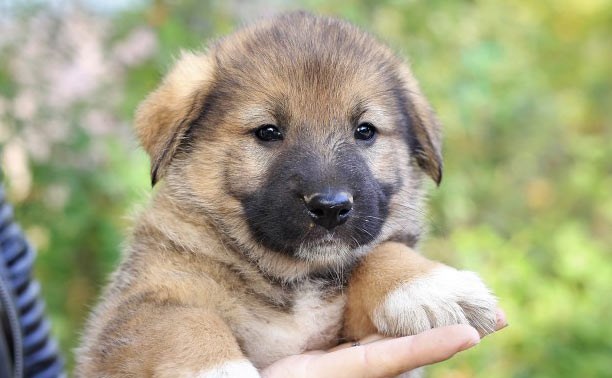Are you a new puppy owner or breeder and are you wondering how and with what you should best feed your puppy? That’s great, because so that your puppy can grow up healthy, you should pay attention to a few points when feeding and choosing the food. You can read here how to feed your puppy correctly from the start and which dos and don’ts you should definitely pay attention to.
Don’t panic before feeding

If you ask yourself what and how to feed your puppy, you will probably feel downright overwhelmed by the wealth of information. However, not all of it is true and sometimes it is also very outdated knowledge.
But don’t panic: feeding a puppy properly isn’t rocket science if you stick to a few basic points.
Choose the right diet
There is a large selection of food options: from fresh meat food (BARF) to wet food and dry food to special types of food such as dry BARF or cooked food – nowadays you can feed your dog in all sorts of ways.
When choosing the right type of food for your puppy, you should look at what fits best into your life. The best way to do this is to ask yourself the following questions:
- Does my dog have illnesses or intolerances and needs a special diet?
- How much time do I have to prepare dog food?
- How much space do I have to store dog food?
- Do I often travel with my dog?
- Can I afford the selected form of feeding?
Of course, all types of feed have advantages and disadvantages. However, with all forms of nutrition you will also find food that is specially tailored to the needs of puppies.
Dry food: pros and cons
Pros
Can be stored for a long time even when opened, does not take up much space, and can easily be taken anywhere.
Can be easily portioned, is relatively cheap, and causes the least waste.
Cons
Often contains too much grain (can lead to obesity) and hardly any liquid. The dog must therefore take in sufficient liquid elsewhere.
Wet food: Pros and Cons

Pros
Many dogs like it better than dry food and contains a lot of liquid.
Is usually a bit higher quality than dry food and can be stored for a long time when closed.
Cons
Once opened, it goes bad pretty quickly.
A not inconsiderable amount of waste is produced by the cans.
BARF: Pros and Cons
Pros
Is considered to be particularly species-appropriate and natural and is put together by yourself.
Individual needs such as allergies, age or size can be catered for
Cons
Must be adapted to the individual nutritional needs of the dog, otherwise, malnutrition will quickly develop.
Requires a lot of time to prepare, a lot of space to store (partly frozen ingredients), and causes relatively high costs.
Choose quality feed
It is essential that you choose high-quality food that is specially tailored to the needs of puppies. Good quality food for puppies should cover the puppy’s high energy and protein needs and should therefore be high in protein. Cereals that contain starch should only be included to a small extent or, ideally, not at all. Potatoes, for example, are better and healthier than cereals as carbohydrate suppliers.
When it comes to puppy food, make sure it has an optimal supply of calcium and the right ratio between calcium and phosphorus! These minerals are particularly important for healthy bone development. If you have questions about the correct nutritional content of the food, you can consult your veterinarian or a nutritionist.
You can recognize high-quality puppy or dog food by the following criteria:
- The feed must be declared as complete feed.
- Puppy food must be specifically labeled as puppy food.
- It should have a high meat content and preferably no animal meal. The meat content
should also be broken down into muscle meat and offal.
- Artificial additives such as flavors, dyes, attractants or preservatives should not be included.
- Sugar, also in the form of molasses, glucose or fructose, is also taboo.
- The ingredients should all be as natural and natural as possible.
- All ingredients should be food grade.
- The grain content should only be small. Vegetables are better than grains.
- Ideally, the meat used should come from animals from organic farms.
Feed the right amount

A mistake that unfortunately occurs again and again when feeding puppies is oversupply or overfeeding. This can sometimes have dramatic consequences, e.g. obesity or even serious skeletal diseases in adulthood.
This phenomenon is particularly common because you don’t see your puppy overfeeding. Because in this case it will not increase visibly, but instead simply grow faster. However, the soft bones are overstrained, which prevents healthy growth.
Therefore, make sure that you stick to the manufacturer’s recommended amount of food, which is adapted to age and size. It is best to weigh the food carefully for this.
However, the manufacturers have often given a fairly large range when specifying the quantity. In this case, a calorie requirement table for growing dogs or a calculated growth curve can help you. You can get these from a good veterinarian or nutritionist. You can also use the weight of your puppy’s parents as a guide.
Attention: Additional treats such as chews and treats also have calories and must be included in the recommended daily amount! So, while it may be hard to resist those cute puppy eyes, remember that you’re not doing your pup any favors by spoiling them with too much food and treats!
Feed not just once, but regularly
Small puppies in particular between the ages of eight and 16 weeks should not only be fed once or twice a day, but regularly. Because growing creatures benefit from several small portions, as the stomach is less burdened. It is therefore best to divide the food into three or four portions, which you offer your dog throughout the day.
If your puppy doesn’t want to eat, that’s not a problem, because not every young dog manages to eat regularly. Then don’t force him to do it, just offer him a small portion again after a few hours.
As your young dog gets older, you can slowly change the feeding rhythm. From about five months, two meals a day are sufficient.
Change food in good time and in peace
During puppyhood, there are two basic changes in food. The first is the switch from mother’s milk to solid food, the second is the switch from puppy food to adult dog food.
Get puppies used to solid food
For the first three to four weeks of their lives, puppies feed exclusively on mother’s milk, which is very nutritious. From about the third to fourth week – when the puppies have milk teeth – you can slowly feed them solid puppy food.
The bitch will continue to nurse the puppies during this time, but they will slowly be weaned from her. From the sixth to seventh week, the puppy then no longer receives mother’s milk.
A porridge made from water or puppy milk mixed with wet puppy food or tartare is particularly suitable for the first additional feeding.
So that the puppies can slowly get used to solid food, you should offer them this feed mixture up to five times a day.
Puppies usually need an adjustment phase first, but will gladly accept the porridge mixture after a short time. The liquid content can then be gradually reduced until the puppies eat the wet food undiluted.
Switching to food for adult dogs
How long you should feed puppy food depends on your dog and the food. As a general rule, your puppy should be fed the junior food until it reaches its adult weight.
This can be as early as around six months for small breeds, but it can take 15 to 20 months for large and giant breeds. If you are unsure about when you should change the food for your young dog, a veterinarian who is well versed in nutrition or a nutritionist is a good contact person.
With every change, it is important that you do not change the food abruptly from one day to the next, but proceed slowly and step by step. Because a sudden change in feed can lead to digestive problems.
It is best to plan at least five days for this and change the feed as follows: on the first day you give 80% of the junior feed and 20% of the new feed. On the second day 60% of the previous food and 40% of the new food. On the third day, 40% of the previous food and 60% of the new food, etc. On the fifth day, your young dog gets 100% of the new food.
Conclusion

Feeding a puppy really isn’t all that complicated. If you stick to the points described above, not much can go wrong.
If you have any questions or if your puppy is not doing well, you should of course always contact your trusted veterinarian.
And then enjoy your puppy time, it is something very special!





























